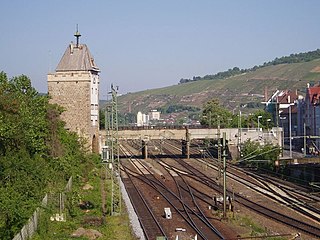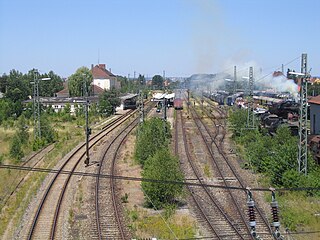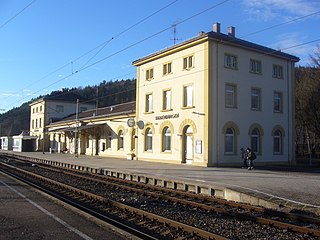
Plochingen is a town in the district of Esslingen in Baden-Württemberg in southern Germany. It lies on the river Neckar, on which it has a river port. With about 14,000 inhabitants, it is part of the Stuttgart Metropolitan Region.

The Stuttgart S-Bahn is a suburban railway system (S-Bahn) serving the Stuttgart Region, an urban agglomeration of around 2.7 million people, consisting of the city of Stuttgart and the adjacent districts of Esslingen, Böblingen, Ludwigsburg and Rems-Murr-Kreis.

The Rhine-Main S-Bahn system is an integrated rapid transit and commuter train system for the Frankfurt/Rhine-Main region, which includes the cities Frankfurt am Main, Wiesbaden, Mainz, Offenbach am Main, Hanau and Darmstadt. The network comprises nine S-Bahn lines, eight of which currently travel through the cornerstone of the system, a tunnel through central Frankfurt. The first section of this tunnel was opened on May 28, 1978. Further tunnel sections were opened in 1983 and 1990, before its completion in 1992. The system belongs to the Rhein-Main-Verkehrsverbund (RMV) and is operated by DB Regio, a subsidiary of Deutsche Bahn.

The Fils Valley Railway designates the Württemberg line from Stuttgart via Göppingen to Ulm. It runs from Plochingen to Geislingen an der Steige through the Fils Valley.

The Bavarian Railway Museum is a railway museum based in the old locomotive sheds at Nördlingen station in Bavaria, Germany. It is home to more than 100 original railway vehicles and has been located in the depot at Nördlingen since 1985.

A Bahnbetriebswerk is the equivalent of a locomotive depot on the German and Austrian railways. It is an installation that carries out the maintenance, minor repairs, refuelling and cleaning of locomotives and other motive power. In addition it organises the deployment of locomotives and crews. In the Deutsche Bahn, a Bahnbetriebswerk is known today as a Betriebshof; the ÖBB refer to it as a Zugförderungsstelle (Zf). Many other countries simply use the term 'depot'. The smaller facility, the Lokomotivstation akin to the British sub-depot or stabling point, is affiliated to a Bahnbetriebswerk.

The name Verbindungsbahn is used in Stuttgart to describe the underground connecting line between the subterranean S-Bahn Stuttgart station at Stuttgart Hauptbahnhof and the tunnel exit at the station in Stuttgart-Österfeld, which connects, via tunnel, the Stuttgart valley and the Filder plateau. The term originates from the planning stages in the 1960s, when similar projects for the S-Bahn München and S-Bahn Rhein-Main were given the same term.

Heidelberg Hauptbahnhof is the main railway station for the city of Heidelberg. In 2005 it was used by around 42,000 passengers per day and is one of the largest passenger stations in the German state of Baden-Württemberg. The station is classified by Deutsche Bahn as a category 2 station.

Tuttlingen station is the most important of the eight railway stations in Tuttlingen in the German state of Baden-Württemberg. The station was built between 1928 and 1933 at a new location and replaced the original much smaller Tuttlingen station built in 1869. Tuttlingen station is a railway node at the intersection of the Plochingen–Immendingen railway and the Tuttlingen–Inzigkofen railway. The station is connected to the InterCity network and is one of the most important stations in the Ringzug network. It serves as the main hub for public transport in the Tuttlingen district.
The Plochingen–Immendingen railway is a main-line railway line in the German state of Baden-Württemberg. It runs from Plochingen via Horb am Neckar to Immendingen, following the upper reaches of the Neckar from Plochingen to Neckartailfingen and from Kirchentellinsfurt to Rottweil, and finally the Danube from Tuttlingen to the end of the line. It was therefore also historically known as the Obere Neckarbahn or the Obere Neckartalbahn. The Rottweil-Immendingen section used to be called the Obere Donaubahn or Obere Donautalbahn.

Tübingen Hauptbahnhof is the largest station in the university town of Tübingen and the district of Tübingen, and a transport hub in the German state of Baden-Württemberg.

Esslingen (Neckar) station is the most important station in the town of Esslingen am Neckar in the German state of Baden-Württemberg and is located 13.2 kilometres (8.2 mi) from Stuttgart Hauptbahnhof on the Fils Valley Railway.

Plochingen station is the only station in the town of Plochingen in the German state of Baden-Württemberg and the most important railway junction of the Esslingen district. It is located 22.8 kilometres from Stuttgart Hauptbahnhof on the Fils Valley Railway and at the beginning of the Plochingen–Immendingen railway.

Wendlingen (Neckar) station is the only station in the town of Wendlingen in the German state of Baden-Württemberg and is a railway junction on the Plochingen–Immendingen railway from which the Teck Railway branches. It is served by regional trains and the Stuttgart S-Bahn.

The Teck Railway is a branch line in the German state of Baden-Württemberg, connecting Wendlingen am Neckar with Kirchheim unter Teck and Oberlenningen. In Deutsche Bahn’s timetable it has route number 761. A branch line once ran from Kirchheim to Weilheim an der Teck, but it is now closed.

Stuttgart North station is a railway station in Stuttgart, Germany, serving the North area of the city. It consists of a passenger railway station on the Stuttgart S-Bahn and a goods yard.

The Stuttgart-Untertürkheim–Kornwestheim railway is an 11.5-kilometre-long freight bypass in the German state of Baden-Württemberg. The double-track electrified main line connects Untertürkheim with Kornwestheim and serves primarily as a bypass for freight around Stuttgart Central Station (Hauptbahnhof). In the Deutsche Bahn timetable as route 790.11.
Süßen station is located at the 50.4 kilometre point of the Fils Valley Railway in the German state of Baden-Württemberg. From 1901 until its complete closure in 1995 the Lauter Valley Railway branched from Süßen to Weißenstein, a district of Lauterstein.

Bempflingen station is located in Bempflingen in the German state of Baden-Württemberg at line kilometre 22.2 of the Plochingen–Immendingen railway. According to the German railway regulations, it should be downgraded from a station to the status of a Haltepunkt.

Immendingen station is a junction station in Immendingen in the German state of Baden-Württemberg. The Black Forest Railway from Offenburg to Konstanz connects with the Danube Valley Railway from Donaueschingen to Ulm meet at the station. Immendingen is also served by trains on the Wutach Valley Railway, which branches at the neighbouring Hintschingen station via Blumberg to Waldshut; regular passenger services have been restored on the section of the line to Blumberg since 2004 as part of the Ringzug concept. Until the construction of the Tuttlingen-Hattingen (Baden) connecting curve in 1934, Immendingen was also the terminus of trains from Stuttgart running over the Plochingen–Immendingen railway and Stuttgart–Horb railway (Gäubahn).



















